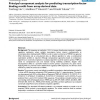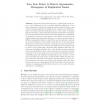680 search results - page 80 / 136 » Genomic computing: explanatory modelling for functional geno... |
BMCBI
2010
13 years 8 months ago
2010
Background: While most multiple sequence alignment programs expect that all or most of their input is known to be homologous, and penalise insertions and deletions, this is not a ...
EVOW
2010
Springer
14 years 1 months ago
2010
Springer
We present an algorithmic approach to solving the problem of chromatic entropy, a combinatorial optimization problem related to graph coloring. This problem is a component in algor...
BMCBI
2005
13 years 8 months ago
2005
Background: The responses to interleukin 1 (IL-1) in human chondrocytes constitute a complex regulatory mechanism, where multiple transcription factors interact combinatorially to...
ALMOB
2006
13 years 8 months ago
2006
The use of Chaos Game Representation (CGR) or its generalization, Universal Sequence Maps (USM), to describe the distribution of biological sequences has been found objectionable ...
RECOMB
2005
Springer
14 years 9 months ago
2005
Springer
Abstract. Asymmetric functional divergence of paralogues is a key aspect of the traditional model of evolution following duplication. If one gene continues to perform the ancestral...


